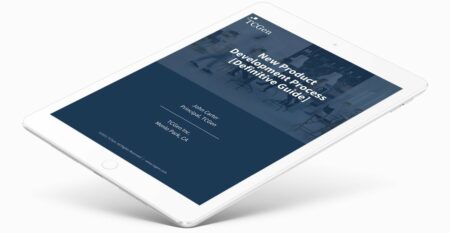What is a Product Development Process?
A Product Development Process refers to the entire range of activities where a company conceptualizes and realizes a new offering. A product concept might originate in the marketplace, or in a lab or workspace, or in the so-called fuzzy front end. Ideas come from customer requirements, too.
New product development usually follows a process divided into stages, phases or steps, by which a company conceives a new product idea and then researches, plans, designs, prototypes, and tests it, before launching it into the market. Below we will discuss the phases of new product development with the help of examples.
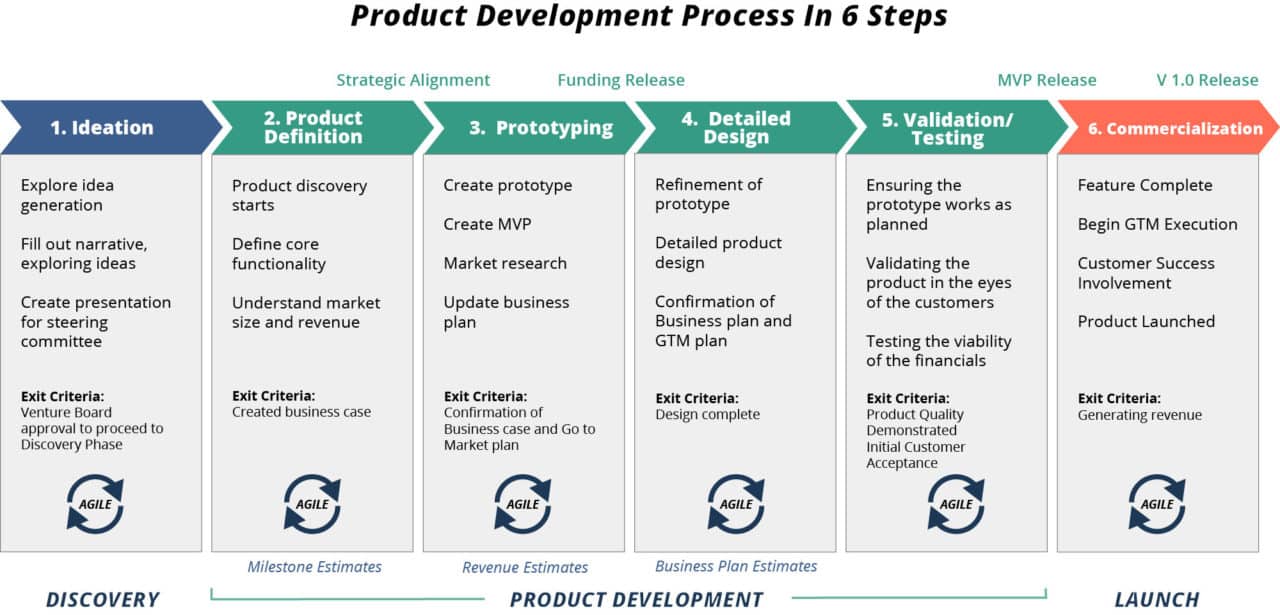
The product development process is the specific series of steps or stages a company uses to achieve its realization of new offerings to satisfy a market need. While nearly every company develops new products or services, product development techniques differ substantially from one company to another depending on the industry, the product type, whether the products are an incremental improvement or a breakthrough innovation. This is probably the most impactful form of process management that a company can undertake, besides managing the product life cycle itself.
In many cases, since organizations rarely focus on this, a product management consulting engagement or a product development consulting engagement can provide the right kind of outside guidance – especially if the gains are in the front end of development.
An accepted approach for more than three (or more!) decades puts a new product idea through a series of steps. These steps culminate in an up-or-down decision made by the Senior Management team in a formal review (often called a “gate”) at the end of each phase.
Are you struggling with your product development? Are your programs not delivering?
- Products Late and Don’t Meet Expectations?
- Development unpredictable?
- Time to Market Too Long?
The 6 Steps of Product Development [NPD]
We will start with a description of the steps to explain the new product development process. A typical product development process has 6 steps with five gates.
- Step 1: Idea Generation (Ideation)
- Step 2: Product Definition
- Step 3: Prototyping
- Step 4: Detailed Design
- Step 5: Validation/Testing
- Step 6: Commercialization
1. Idea Generation (Ideation)
This first step or stage of the Product Development process, often called “Ideation,” is where new product concepts originate. Often this step is a result of an idea screening to select the next product effort, and is more clearly defined in new product development. Following best practices, businesses form a small team to explore the product roadmap and perform…
- The initial definition of the product concept
- Business analysis (including SWOT analysis)
- Market research
- Technical and market risk
The idea stage is often the most important step for brainstorming new products because it is where most product ideas come from. Sometimes a SWOT analysis (strengths, weaknesses, opportunities and threats) analysis is used as a vehicle to prioritize ideas in this first step.
From Idea, To Concept, to MVP
Often product development starts out with a product manager realizing that the sales are lagging their forecasts because it is late in the product life cycle. The manager wants to act, but sometimes they lack a methodology. Other times the motivation is that someone in engineering (or sales) comes up with a bare idea out of the blue, not driven by the product development cycle (not all products come from product managers!), but because of some independent brainstorming. Finally, it can come out of a deliberate marketing strategy and product roadmap.
In all cases, product managers need to turn an idea into a concept. Once you have a concept firmly in mind, you can think about concept development and testing with prospective customers to make sure you are on the right course. If the concept is super simple, you could even go directly to a Minimum Viable Product (MVP) and start getting real feedback.
Getting the product concept wrong at this early stage wastes time and increases opportunity cost. Note not all new product ideas come from the inside – the Corporate Development organization and executives should be constantly scanning for new product ideas. Marketing efforts should also including active competitive analysis and market scanning. Engineering should be brainstorming, too.
It is at this stage where the target market, target audience (including Personas) and target customers are proposed. If the product goes through distribution, then the distributors are included as customers in this ideation step. Idea screening is performed in this phase.
2. Product Definition (Discovery)
Sometimes called “scoping,” or concept development, this step involves refining the definition of the product concept and ensuring that the team really understands customer requirements. In a startup this step is often called Discovery. The design team is assembled in this phase. The team creates the first detailed assessment of the technical, market and business aspects of the new product concept and determines core functionality. A template, or approach, for design thinking might be useful in getting started.
Sometimes mockups are used to obtain early feedback on product market fit. These mockups can be primitive, for example paper prototypes are commonly used to get early feedback from test marketing. If this is an incremental product, then concept design can begin. For breakthrough products, the team may consider simulations to get user feedback. The newer the product category is to the company, the more concept testing is required. The basic goal of product discovery techniques is to ensure that the ideas are good and will satisfy customers.
Concept design often begins in this phase. The design team can begin to visualize the end product and can communicate this to potential customers (in software, this simpler than in a complex system or hardware product).
Marketing Strategy Development
Developers and managers explore and define the key points of differentiation for the new product. This step in development, if done improperly, can increase time to market or cause the product to misunderstand the needs of the market. Because this step is often before really ramping up the team, the alignment with the product development strategy is also very important. Although it is early, often metrics such as ARR (Annual Recurring Revenue) or Acquisition Costs are estimated. Clearly a product roadmap can be instrumental in guiding (or developed with) the marketing strategy.
Business Analysis
After the first stage of development, business analysis is performed. The team would look at similar products, perform a competitive analysis, and begin to map out the distribution strategy, including ecommerce. This is done to ensure the margins returned to the firm will meet thresholds. The market strategy will also guide the estimates of advertising and PR, again which weigh into the ROI calculation for the new product. Often a three year Profit and Loss plan is part of the business analysis.
Development Costs
As part of the business analysis, and with an understanding of the product definition, the team can develop estimates of development costs at this stage of the development cycle. This cost also goes into the business analysis in order to calculate ROI or IRR metrics.
3. Prototyping
This step in the product development process justifies the company’s investment in the development of a product by requiring the team to create a detailed business plan. Best practices usually involve intensive market research and a clear project management approach. The team thoroughly explores the competitive landscape for the new product and where the proposed product fits within it, while also creating a financial model for the new offering that makes assumptions about market share. Besides concept testing, pricing is determined in this step.
For tangible new products, such as hardware or mixed systems, the team also considers the manufacturability of the proposed new product, and this includes the sourcing of the product if out sourced. By the end of this phase, Senior Management should have a clear idea of what they’re investing in and how it will perform in the marketplace.
This third step in the product development process is critical because it reduces the market risk for the new product. This is the stage where you can perform test marketing because of the existence of prototypes that you can show to customers. Software development can do these tests earlier because of the relative ease of creating realistic user interfaces.
4. Detailed Design
In this phase, the focus is on product design but also refinement of the prototype of the product. In most cases teams alpha-test the prototype, working with customers in an iterative fashion: getting their feedback and incorporating it into the prototype. In parallel, marketing, sales and manufacturing begin to create the launch and manufacturing platforms to support the emerging product. This fourth step in the product development process is sometimes called Development, and sometimes incorporates the next step, “Validation/Testing.”
5. Validation and Testing
Validation and testing means ensuring the prototype works as planned. It also means validating the product in the eyes of the customers and markets, while testing the viability of the financial model for the product.
Everything in the business case, and everything learned from customers during the Development phase comes under scrutiny and is tested in “real world” conditions as much as possible. The marketing strategy is also confirmed at this point. If anything in the business case or prototype needs revising, this is the team’s last chance to do so. This is the last step before the final product is ready for the market. Often test marketing, or beta testing (depending on the type of product), is performed at this stage to help validate the go to market plan.
6. Commercialization
During this step of the product development process (including the manufacturing process), the team realizes everything required to bring the final product to market, including marketing and sales plans (or sales training if necessary) for the market introduction. The team, including project management, begins to operationalize the manufacture and customer support for the product and supports the product introduction. That is why this step is called the Commercialization Phase. Test marketing may continue to enable the company to have the greatest success with the launch.
Gate Reviews
Each of these six phases ends in a gate review where the team presents to management specific, pre-defined deliverables, and demonstrates the outcomes required to move on to the next phase of the product development process. Each of these reviews ends in a go/no-go decision. In other words, Management has five opportunities to kill the project before committing to its launch. Often, the meaning of new product development is translated into Gates – this is obsolete thinking.
However, the world is moving away from this waterfall product development approach. It is too process heavy and encourages unnecessary meddling from Senior Management. Compare your gate reviews and other aspects of the process with our product development checklist.
Waterfall vs Agile Product Development Processes
Currently, there are two primary approaches to the product development process – and we know this through case study after case study. The first is a waterfall approach, a generic term for traditional product development in which there are discrete steps and milestones. It is called waterfall product development because, in this approach, teams continue on to the next stages only after milestones are met, i.e. the flow is one directional only. We often see these types of stages and gates processes in our management consulting engagements. Most companies want new product development techniques that blends these two approaches – a so called hybrid approach.
Agile Product Development Process
Agile product development processes, on the other hand, are increasingly more common because they can create new products that delight customers using fewer resources. The Agile approach relies on sprints, cycles that combine development with customer testing. Most all organizations that say they are Agile are really using Agile between major milestones to develop their products. This is a hybrid approach that offers the best of both worlds and an approach used in our agile consulting.
Minimum Viable Process: A Modern Approach
The traditional six-step process described above is the established process you’ve read about in the textbooks and seen in the training videos. Some of these processes might have five steps, or even seven or eight steps, but the basic idea is the same. This is state-of-the-art product development — for 1985. But today’s fast-moving markets, rapidly changing technology, and agile teams need a lean approach.
We recommend drawing elements from both waterfall and agile to create a modern development product process – that way you get the best advantages of both systems. We also recommend that you have a rapid and simple escalation process. This is a bit of contrast from Robert Cooper who has historically advocated for a fixed series of phases and reviews.
This new approach is to have a Minimum Viable Process: enough process but never too much. It begins with a simple realization that any product development process boils down to two needs:
- Enable executive oversight at the inflection points where they need to make investment decisions and,
- Guide the team toward risk reduction
Lengthy, onerous reviews, where the team must justify its continued existence every few weeks or months, creates too much bureaucracy and leaves the team with too little flexibility. It makes Senior Management the customer throughout the process. Further, while adherents of the traditional phases and gates approach acknowledge that product development is an iterative activity, they continue to try to make it fit into a sequential, linear scheme.
“Enable executive oversight at the inflection points where they need to make investment decisions and guide the team toward risk reduction”
The Minimum Viable Process approach involves a subtle but important change in thinking. While the phases and gates approach contains a series of sequential steps, the Minimum Viable Process recognizes that each portion of the process has many activities done concurrently and iteratively. Rather than fulfilling a rigid set of deliverables, the team engages with Senior Management in three check-ins that show that the concept is sound, that there is a fit between the market and the product, and that everything is prepared for the product launch. These check-ins demonstrate that continued investment is warranted.
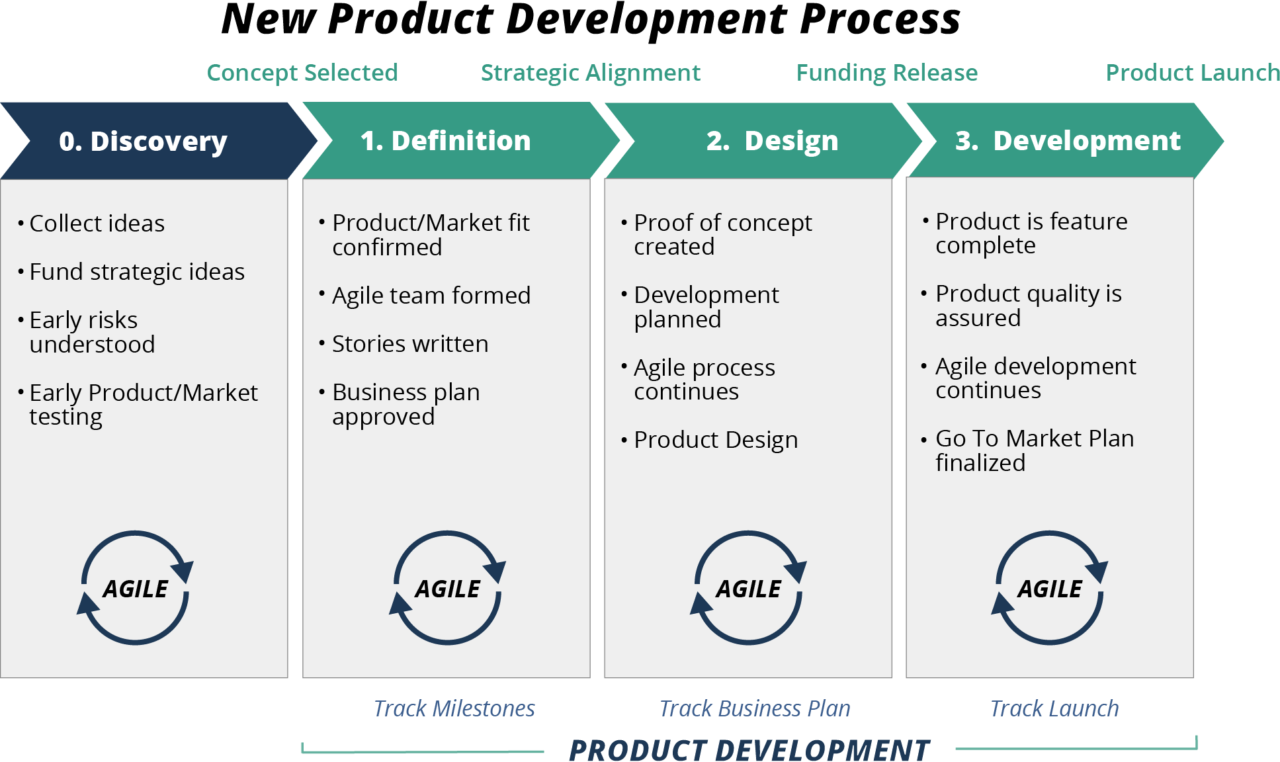
Rather than having pre-set deliverables and outcomes that the team must meet in order to pass a review, the team continues to affirm throughout the process that it is meeting a set of broad parameters that define the project. Often these key deliverables are determined in a product development consulting engagement, where best practices are imported and modified to fit your unique situation. If it’s meeting these parameters, Management should leave the team alone; if it’s not meeting them, then the team needs a lean escalation process to inform the Senior Management and get back on track.
Here’s how it works. At the beginning of a project, possibly after having a product idea but before the company invests big dollars, the development team and Senior Management team come to an agreement around key parameters for the project such as:
- Product Cost
- Features
- Schedule
- Quality
- Reliability
These parameters must have a quantitative threshold that the team must not exceed, as in the diagram below. We call these quantitative parameters boundary conditions. This approach implies that the team has already done sufficient homework to set these parameters accurately and to make them quantitative.
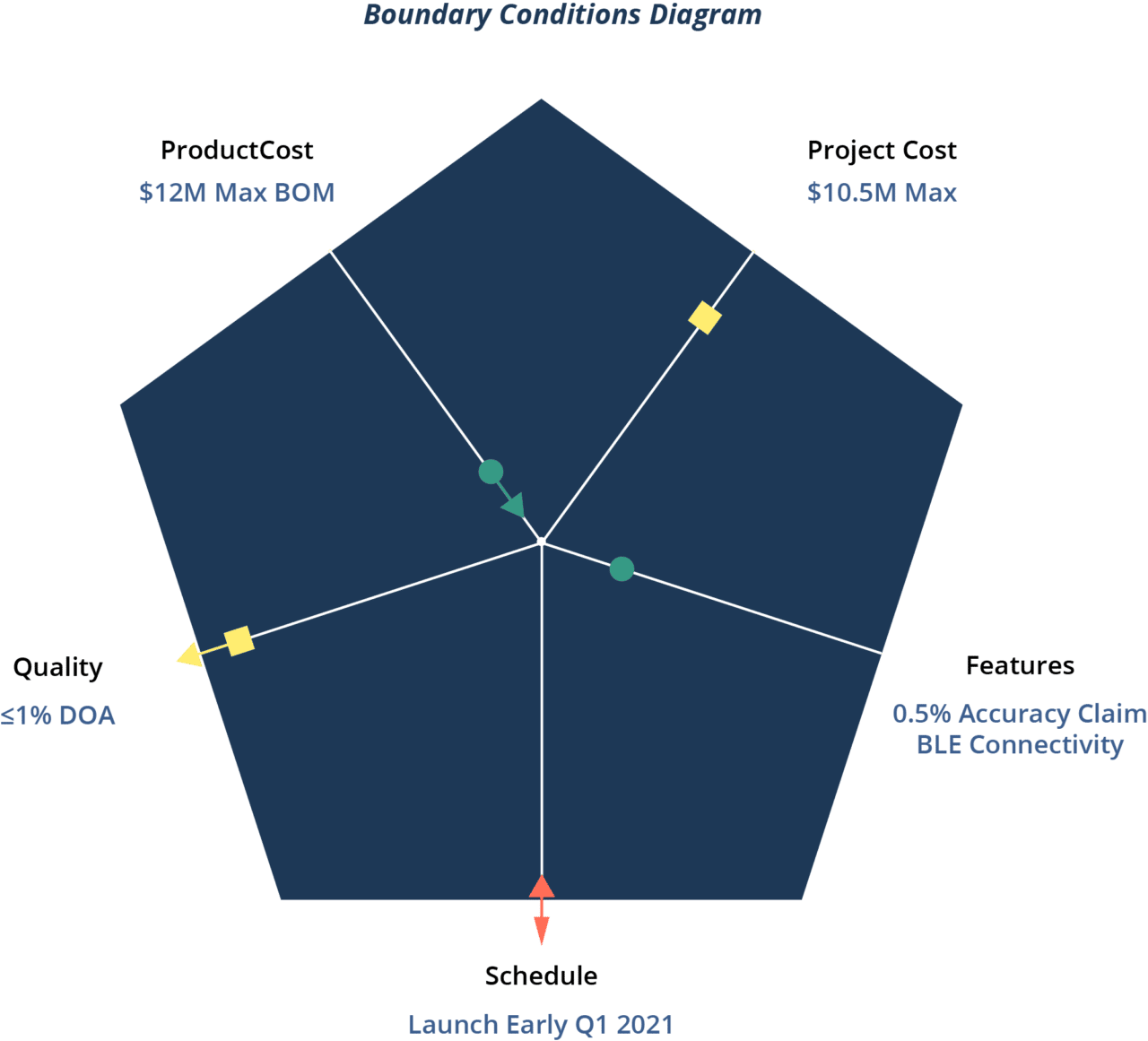
Once the team and management agree to these boundary conditions, the team is left alone to reduce the risks associated with meeting each condition. If it looks as though the team is on track to achieve its aims, then Management does not meddle.
In addition, In a Minimum Viable Process there are no rigid reviews with a pre-fabricated set of deliverables. These reviews are replaced by the three check-ins throughout the process where the development team meets Management’s need to ensure that its investment is protected. They demonstrate the viability of this continued investment by showing that the development team is reducing risk in every conceivable category: market risk, technical risk, competitive risk, etc.
If at any time – and not merely at predetermined “gates” – the team perceives that it will not achieve one or more of its boundary conditions (called a “boundary break”), then the development team informs the Senior Management team and there follows an escalation process called an Out-of-Bounds Review.
In such a review, the team communicates about the boundary condition break they anticipate. The team also proposes a solution to the boundary break. If the Management team agrees with this solution, then they approve it and the team moves forward on this basis. If the Management team does not agree with the proposed solution, then there follows a face-to-face meeting where all stakeholders negotiate a new boundary condition. The team then proceeds based on this new specification. Such reviews should take place in days or in a week, and not in weeks or months.
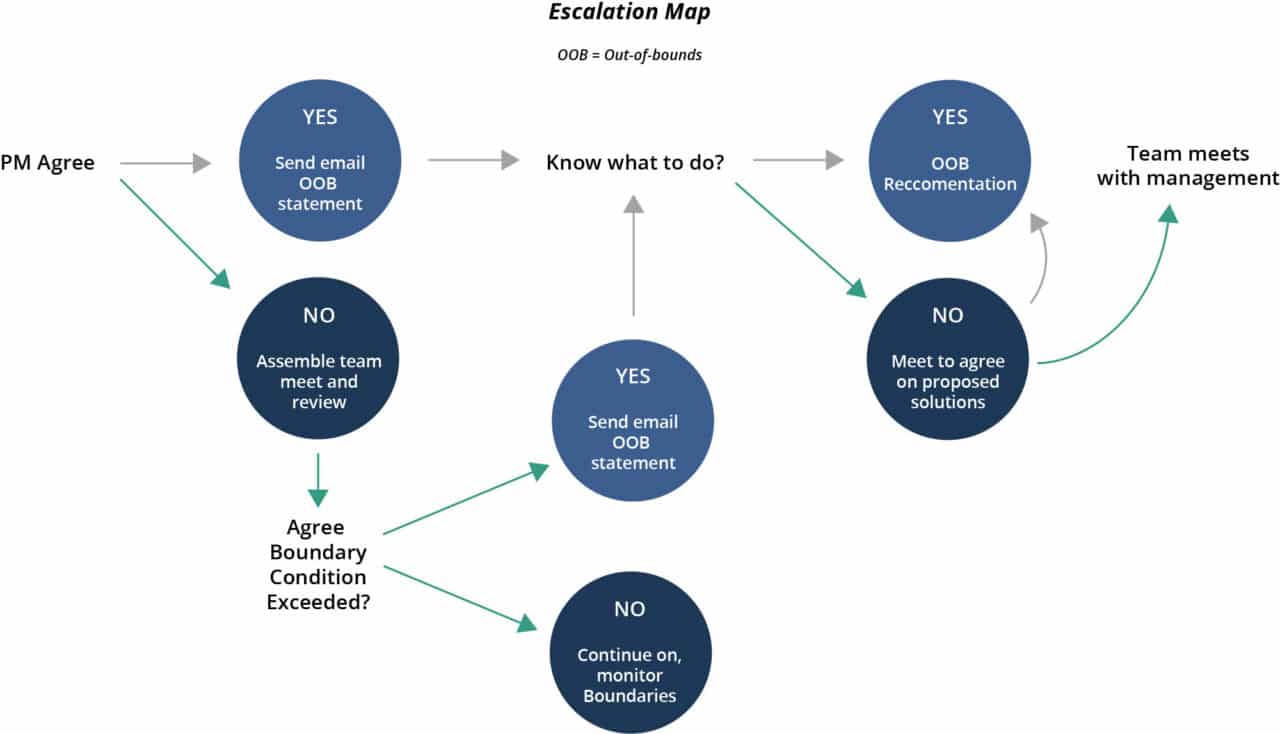
Establishing Boundary Conditions coupled with the Out-of-Bounds reviews reduces bureaucracy and paperwork. It is a lean approach to new product development where issues are resolved quickly. Most importantly it preserves the Management team’s confidence in their investment, while guiding the development team to continually reduce risk, by working to a clear set of objective parameters.
From Six Steps to Three
A Minimum Viable Process has a maximum of three major steps, with three check-ins after each step.
- Step 1: Concept Fit
- Step 2: Product/Market Fit
- Step 3: Development
Think of each of these phases as having a set of activities associated with it and exit criteria that the team must fulfill to enter the following stage. Here are the typical activities and criteria for each of these three phases:
Step 1: Concept Fit
Activities for the Concept Fit stage ensure that product ideas are the best product ideas…
- Product ideas are congruent with the vision
- The team is free to innovate and iterate
- The technology is tested
- Projects are staffed properly with the right resources
- Projects are free from anything that impedes fast and iterative development
- There is a meaningful commercial potential
By the end of this phase, the team should have a clear leader with entrepreneurial capability. The team should demonstrate to management that the time-to-revenue is foreseeable, the potential market share large, and that the revenue potential is large enough to make a difference to the company. The proposed business model should be adjacent to the company’s overall model. That means that the business model for the project should resemble how the company, in general, does business.
There are also brand and customer issues to consider in this phase. This phase should include market research and clarify how the proposed product will leverage the company’s brand, and the team should be able to describe the product’s unique value proposition. The team should also consider the proposed product’s fit with the current distribution channels and its projected customer base.
At the end of this phase, the development team has a brief check-in with management to establish the Boundary Conditions for the project and to ensure that the proposed project meets the company’s current strategic priorities.
Step 2: Product/Market Fit
Activities during this phase of the development process include:
- Vetting the technology
- Defining use cases
- Estimating the cost of development
- Confirming and quantifying the commercial potential
By the end of this phase, the team should have tested prototypes with users to confirm fit with the intended market. They should have not only identified use cases but also pegged where the solution best fits its market. The team should also have considered the technical and market risks associated with the project. In the case of truly new products, extra emphasis should be on idea generation – but also being very careful in selection of the best from the set of potential new products.
To exit this phase, the team also needs to demonstrate that it has a detailed budget, has calculated accurately the costs associated with developing the product, and has defined its profit potential.
During a check-in at the end of this phase, the team defines the product in greater detail, and demonstrates its technical feasibility. The team roughs out the timing and budget for the project, and perfects the business model.
Step 3: Development
Activities in this phase of the development process include:
- Developing the Minimum Viable Product (MVP)
- Confirming the business plan
- Drilling into the research to learn more about who customers are and how to reach them
- Developing any supporting infrastructure that the customer needs to use the product
- Training the salesforce (if required)
The Market Launch phase is where the product is prepared to meet real customers. During this phase, the team creates a series of iterations of its product prototype in close communication and collaboration with customers.
This is also the point-of-no-return where a company assesses the product’s launch readiness. Areas of focus include product quality, product performance, getting the optimal feature set, and demonstrating customer support capability.
To exit this phase is to enter the selling phase. Management must approve the team’s marketing spend and go-to-market plan. The team may also plan for the future by identifying the features that they will realize in future generations of the product. The team must demonstrate that the MVP works as planned and that the market and sales plan is ready to go.
A Series of Releases
Think of the final result of each of these phases or steps as a product release. In this three-stage scheme, each step is an element in a larger release plan.
- The Concept Fit phase ends with a release to a funded team
- The Product/Market Fit phase ends in a release to the organization
- The Development phase releases the product to the world
With this mindset, Agile methods dovetail with this three-step Minimum Viable Process to create a hybrid approach that combines the best elements of old-fashioned milestones-based, phases and gates processes, and more nimble, lean methods. For instance, for each project, the development team and Senior Management should craft a set of exit criteria for the three phases, the “must haves” that the team needs to continue to the next phase, in keeping with the boundary conditions they have established.
Example of Minimum Viable Process
To tie the Minimum Viable Process to the Agile approach, the development team could tie each exit criteria to a specific sprint. For example, to exit the Product/Market Fit stage, the management and development team may decide that they need to map the dependencies the development team has on other teams. It might tie the creation of this map to a sprint, planning that it will have the dependency map on hand by the end of Sprint 1; a detailed budget at the end of Sprint 2; and a clear statement of profit potential by the end of Sprint 3.
A Modern, Lean Product Development Process
Old-fashioned, sequential phases and gates processes tend to take a one-size-fits-all approach to new product development. They put projects through a set of rigid milestones, whether or not these milestones apply to the project at hand. In a Minimum Viable Process, the project has only the milestones it needs.
Example of Incremental Products
For example, if you are developing an incremental improvement on an existing app, there may be no need to demonstrate the Concept Fit. If your existing product is successful, then you’ve already proved the concept as well as the Product/Market Fit. Such a project might need only one check-in between the team and management.
There’s no need to have three check-ins where they don’t add value – and if there’s no reason to have three, there’s certainly no reason to have five! In fact, having three check-ins might subtract value by adding waste and bureaucracy. Have only the milestones that make sense for your project.
Define the exit criteria for each check-in in terms of the set of overall boundary conditions that the development team and Senior Management have defined for the project. This approach, combined with a Minimum Viable Process with only three check-ins, enables management-by-exception. This means that Management intervenes only when it looks as though the team is going to violate one or more boundary conditions.
This management-by-exception approach is the lean way to develop new products. Combined with the three-step, Minimum Viable Process described above, it ensures that companies have the predictability and process quality that management needs to make good investment decisions, while also ensuring that teams spend most of their time reducing risk and adding value to products in ways that customers actually care about.
And this is what the Minimum Viable Process is all about. Call it the Goldilocks Approach: getting the process just right. Not so little process that chaos ensues, but not so much process that the team is distracted from its most important priority: creating products that delight customers and meet business objectives.

